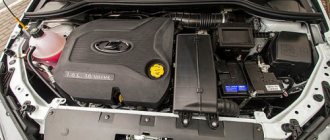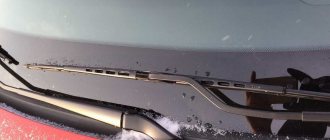Which gasoline to choose AI92 or AI95? This question worries every car owner. If we talk about AVTOVAZ’s new product, the Lada Vesta, it is worth noting that the manufacturer recommends using AI95 gasoline. To save money, many people start using cheaper AI92 fuel. And some, on the contrary, spare no expense and fill the tank with AI98 or AI 98G-drive..
In the operating manual Lada Vesta manufacturer
indicated that only unleaded gasoline “Premium Euro-95 GOST R 51866” or “AI-95-K5 GOST 32513-20013” is allowed for use. If necessary, it is allowed to use gasoline with an octane number of at least 92.
What kind of gasoline should I use?
The Lada Vesta tank must be filled with the type of fuel recommended in the manual that comes with the car. In addition, the type of gasoline is duplicated on the back of the Vesta hatch. According to official information, AI-95 must be filled into the Lada tank - this is due to all its 1.6-liter engines (86 hp, 106 hp, 114 hp).
What kind of gasoline should you fill Vesta with to protect yourself from problems?
In this case, it is highly advisable to do without experimentation, since the power unit is initially configured for a specific type of fuel. When filling the tank with AI-92 gasoline in the Lada Vesta, during dynamic acceleration and heavy loads, the knock sensor will start to work, and this will result in unstable engine operation and loss of speed. In addition, overheating of the motor and its accelerated wear are possible. And the possibility of the cylinder head burning out should not be discounted, as this may result in a major overhaul (replacement of valves, pistons and other components).
Information about the type of fuel is on the back of the Lada Vesta hatch.
Recommendations for refueling your car
To ensure that the engine of your Lada Vesta is satisfied with the fuel it consumes, follow the following recommendations:
- Do not fill your car with gasoline with an octane rating not recommended by the manufacturer.
- It is better to fill up gasoline at trusted gas stations. This, of course, also does not provide a 100% guarantee, but large gas station chains are more loyal to pre-trial resolution of problems that have arisen.
- From the previous paragraph it follows that you must always save receipts after refueling.
- Try not to leave the fuel tank empty - in this case, condensation will form on the walls, which will then mix with gasoline.
- Change the fuel filter more often than stated in the technical instructions for your car.
Gas-gasoline Lada Vesta was able to travel a thousand kilometers at one gas station
An experimental version of the Lada Vesta, which uses not only gasoline but also methane gas as fuel, was able to travel a thousand kilometers at one gas station during testing. These tests, which were completed successfully, marked the beginning of serial production of the bi-fuel Lada Vesta. Officially it will be called Vesta CNG. If you have already rushed to the dealers for a brand new bi-fuel Vesta, then stop, there are no production versions on sale yet. When they will appear, none of the AvtoVAZ employees yet knows, or knows, but is silent like a partisan. But it is known that the first models of the bi-fuel Vesta will soon arrive for testing in corporate factory fleets.
For the first time, the gas-gasoline Lada Vesta was officially presented exactly a year ago at Innoprom 2016, an innovation exhibition held in Yekaterinburg. According to AvtoVAZ engineers, the bi-fuel car turned out to be very economical; if driven correctly, the bi-fuel Lada Vesta will be able to travel not a thousand kilometers, but even more than a thousand. How much more, however, is not specified. The driver can switch from one type of fuel to another at any time while driving. In addition, AVTOVAZ engineers claim that using methane as fuel significantly extends the life of a car engine, and the fuel cost savings are more than three times.
The engineers hid a metal-composite gas cylinder in the luggage compartment, right behind the back of the rear “sofa.” It is designed for ninety liters of fuel, but up to eighteen cubic meters of methane can be pumped into it. The gas cylinder is equipped with an integrated fuse and valve, which eliminate the possibility that the cylinder body will crack or rupture. Also, if a gas line is damaged in an accident, methane will not be able to escape. By the way, methane is much safer than propane or butane, because in the event of a leak, it does not accumulate in one place, but is dispersed in the atmosphere, so it simply cannot explode - for an explosion a certain density of gas is needed in one place. But butane or propane can explode.
When will the average citizen wait for the Lada Vesta CNG in dealer showrooms, and, most importantly, how much he will have to pay for this economical car miracle, no one close to the topic has yet reported.
Recommended article: UAZ Patriot with automatic transmission is not yet known when it will appear
By the way, a year ago Ford Sollers also released a test batch of bi-fuel Ford Focuses. The other day, AVTOVAZ management announced that soon, by the end of this year, the plant will produce two station wagons, and next year three more domestic new products will appear.
You can also read on this topic:
Qoros: coming soon to Russian spaces
More and more pick-up trucks are being used in Russia
The Koreans have announced a new price list for the Russian version of the SsangYong Actyon
The new seven-seater SUV Volkswagen Teramont was photographed by spies without a camouflage net
The Vesta model will have the Yandex.Auto system installed.
Sergey June 8, 2017
Published in: Automotive news - new cars
Tags: Lada Vesta CNG, bi-fuel Lada Vesta, Russian cars
Fuel quality
A preliminary assessment of the quality of gasoline can be given visually - by its color. High-quality AI-95 and AI-95 are almost transparent with a slight yellow or blue tint.
Absolutely transparent, colorless fuel is straight-run gasoline, unsuitable for engines. Fuel with a red tint contains metal-containing additives (manganese, ferrocene), while rich yellow fuel contains monomethylaniline.
If gasoline does not visually cause suspicion, you can refuel.
Bon appétit!
First, fill in AI-92. When the trip computer of the first Vesta showed dashes (the minimum numerical remaining power reserve is 30 km), we prepared for the fact that the engine was about to stall. Not so! As it turned out, the cars easily drive several tens of kilometers before the engine stops.
The Vestas showed absolutely the same average consumption of the “ninety-second” - 6.7 l/100 km. We take it as a starting point for subsequent measurements. An interesting detail: the trip computer of the five-door SW Cross shows the fuel consumption almost without distortion, but the sedan underestimated the result by a liter (it showed 5.7 l/100 km in this mode), and the situation was repeated in subsequent measurements. Very strange behavior - the counters have the same design.
Let's move on to AI-95. Both testers did not notice the difference in the behavior of each of the cars on higher octane fuel. The resulting fuel consumption was also not surprising: the SW Cross station wagon dropped one “ten” - to 6.6 l/100 km. The less powerful sedan saves a little more: minus 400 ml, the result is 6.3 l/100 km. But with the same driving sensations, why pay more? Without a calculator, it is obvious that in such modes it is cheaper to drive the AI-92.
For dessert - AI-100. And then a surprise awaited us. Neither SW Cross nor the “simple” Vesta could improve the result of “ninety-five”! Elite fuel did not provide any advantage, and the elasticity of the 1.6 engine turned out to be even worse. Although this is not such a sensation: almost five years ago we already tested the Chevrolet Cobalt and Nissan Almera sedans in a similar way (ZR, No. 12, 2013), and then the “premium” AI-98 was also not surprising.
But this is driving in steady conditions. Perhaps instrumental dynamics measurements will open our eyes?
Interior of Lada Vesta 2022
We characterize the interior design as follows:
- The steering wheel is made in a classic style, has two spokes and double lower support.
- The instrument panel has three wells in which the main indicators are placed: speed, revolutions, fuel volume, and so on.
- In the expensive version of the equipment, a multimedia system display is installed on the center console. Below it are placed several push-button control units, one of them is responsible for climate control control.
- Many interior elements have a complex shape and design. Plastic was used for finishing, which imitates chrome strips.
- Fabric is used to trim the seats. Moreover, even in the expensive configuration, the trim is presented in fabric; leather trim is not provided.
The use of modern technologies in the production of this sedan determines that the car looks quite attractive, the elephant can be called practical and quite comfortable.
Compare configurations and prices
The cars differ in the cost of their configurations. The base price for Vesta SW is 654 thousand rubles, and its off-road modification is offered from 770 thousand rubles.
The initial configuration of SW Cross includes the following options:
- Combined seat upholstery made of fabric and eco-leather.
- LED lighting of the interior and entry and exit points in the driver's and front passenger's doors.
- Climate control system instead of standard air conditioning.
- Heated windshield.
- Rain and light sensors.
- 17-inch alloy wheels instead of stamped R15 ones.
All versions of SW cars are cheaper than the more equipped SW Cross.
FakeHeader
Comments 30
I use 95 G-Drive at Gazprom, time-tested gasoline in more than one car.
It is better to fill in 95, because... at our gas stations, instead of 92, they pump gasoline at an octane rating of 88...89. 92nd - if only you are very sure...
For a long-distance trip I filled it with 95 and the consumption was 6.6 l/100 km. I'll pour 95.
Good decision! My brother returned from the south - he refueled with 92 near Krasnodar... while the power system was being repaired, they took a fuel sample - 80 octane ((... Now, if I had refueled with 95, I could have gotten home better...
Only 95, I can’t refuel Kalina with 1.6 or Vesta with 1.8, it immediately detonates and drives worse.
Well, I don’t have concrete at 92, but I think at 95 the ride will be more cheerful and eat less.
Only 95, I can’t refuel Kalina with 1.6 or Vesta with 1.8, it immediately detonates and drives worse.
Well, I don’t have concrete at 92, but I think at 95 the ride will be more cheerful and eat less.
95, I haven’t held a 92 pistol in my hand for 6 years. A long time ago, at 1.6 8kl, I noticed that the 95 runs smoother, heats up less, the traction is better and the consumption is less
92. pulls excellent, 6000 mileage. On the highway you can fill it with 95, it will be faster when overtaking.
I use the 95th, on the 92nd the consumption is higher and it drives worse, for the money it turned out to be even more expensive for me than on the 95th.
Engine 1.6 I first tried to pour 95 during break-in, then switched to 92, then again I filled several full tanks with 95. I understood one thing, that the difference is only in price, neither in traction nor in consumption, there is no difference at all, maybe it’s only at the level of self-hypnosis, all this, in the end I use 92. Now the mileage is almost 16,000, there are no problems with consumption and traction, so whatever you say, it’s more profitable to drive 92
No one has been using 92 for a long time, the ninety-fifth can be obtained by adding, for example, ferrocene to 92. The manufacturing plant is located in Izhevsk, respectively, tests take place there and in Togliatti, and they fill in regular gasoline, which means if they write that 92 is possible, that means The motor runs fine on it. Here it’s up to everyone to ride one and the other and decide which one they like best. I choose the 92nd because it starts easier and faster, the consumption does not increase significantly, and it always works the same, but there is no stability on the 95 and 98.
LADA > Vesta SW
LADA > Vesta
Russia is one of the largest oil-producing countries, but our gasoline prices do not fluctuate along with the prices of black gold, but are exclusively growing. At the beginning of last summer, the mass varieties AI-92 and AI-95 unexpectedly added a few rubles each, while the premium AI-98 and AI-100 jumped far beyond the psychological threshold of 50 rubles per liter. And the eternal debate about the optimal choice of gasoline flared up with renewed vigor.
Many suddenly remembered that their cars could be fueled with “ninety-second” - and for the sake of saving money they switched to it.
Others are still confident that the expensive “ninety-five” and even more so the “ninety-eighth” provide the car with better dynamics. And when driving quietly on high-octane gasoline, they say, consumption drops - and it will be even cheaper than on “ninety-second”!
Do similar theories work in relation to cars with modern, but not highly accelerated engines?
We took two editorial Vestas. Sedan with a 1.6‑liter engine producing 106 hp. and the AMT robot symbolizes the choice of a person who is not in a hurry: you don’t need a lot of power, the gearbox switches itself - that’s nice. The SW Cross station wagon with a 1.8-liter 122-horsepower engine and a manual gearbox will certainly be preferred by those who always want to have “reserve under the pedal.”
Lada Vesta 1.6 AMT (manufacturer data)
Power
106 hp at 5800 rpm Torque
148 Nm at 4200 rpm
Acceleration time 0–100 km/h
14.1 s
Top speed
182 km/h
Fuel consumption: urban / extra-urban / combined
9.3 / 5.5 / 6.9 l / 100 km
Recommended gasoline
minimum AI-92
Lada Vesta SW Cross 1.8 MT (manufacturer data)
Power
122hp at 5900 rpm Torque
170Nm at 3700rpm
Acceleration time 0–100 km/h
11.2 sec
Maximum speed
180 km/h
Fuel consumption: urban / extra-urban / combined
10.7 / 6.4 / 7.9 l / 100 km
Recommended gasoline
minimum AI-92
Transmission oil
The service book states that after a mileage of 180 thousand km the oil in robotic and manual transmissions needs to be changed, but the experience of Vesta owners suggests that the oil in them should be updated much more often - for every 60 thousand km.
You will need 3 liters of oil of quality class GL-5/GL-4 (according to API) with a viscosity of 75W-80. It’s the same with the variator: although the instructions don’t provide for changing the oil at all, you can extend the service life of the transmission if you change the fluid every 60 thousand. How much liquid is required will be determined by the method by which the change is made, but it is better to stock up on a couple of 4-liter canisters.
Updated Lada sw cross
It was first presented to customers last summer. Together with the station wagon, the sw cross model appeared.
It visually stands out among other AvtoVAZ cars. Along the perimeter of the car there are plastic linings that are used as decoration and also for protection. The bumper has been modified: more voluminous and streamlined. Fuel tank cap opens with the push of a button, shark fin antenna, factory size 17 alloy wheels.
The interior has also been improved. The front instrument panel is illuminated with white light, the area of the rear row of seats is illuminated using a lamp. The front passenger/driver seat is divided by an armrest, which is used for comfort, and also as a panel on which there is a power outlet, a USB port, and a button for turning on the heated rear row of seats. Orange-colored inserts were used for interior decor.











